What to consider when ordering windows?
5 TIPS ON HOW TO ORDER THE RIGHT WINDOWS?
Window technology has evolved significantly over time, with a particular emphasis on making homes more energy efficient than before. Here are the main window functions and features to consider when buying new windows and doors.
Windows need to be able to withstand strong wind and rain in summer and snow and ice in winter. Over the years, changing weather conditions should not make it difficult to use the windows or alter their properties. It is not always necessary to replace the whole window – you can start by adding additional insulation around the window (e.g. by replacing the glazing unit) or by adjusting the windows to improve energy loss through the windows.
If your existing windows are old and problematic (windows won’t open, wind blowing through, water damage to window sashes/frames), you should consider replacing your windows. Problematic windows can lead to bigger problems – snow blowing into the room in winter, water starting to run into the wall – resulting in damaged wall structures.
It’s worth taking the first steps to buying new windows by identifying your needs, design, budget and window features. Buying a window is a big responsibility, which means that any wrong decision or excessive cost-saving measure will have a major impact on the final result.
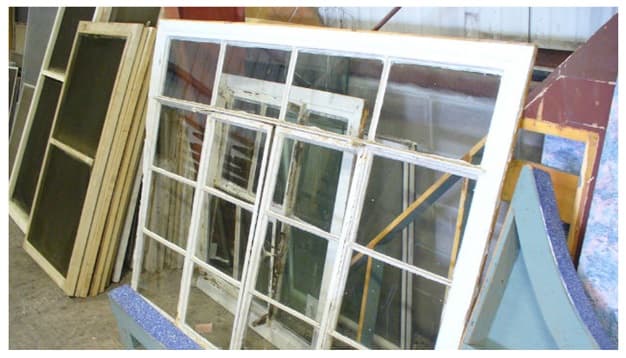
1. CHOOSE WINDOW MATERIAL
Frame material
Perhaps the most fundamental choice to be made is between window frame materials. Wood or PVC? One myth that needs to be debunked time and time again is the belief that a wood-framed window keeps heat better than a plastic one. Actually, it doesn’t, and there’s a very simple reason for this – the frame only accounts for 10-12 percent of the window’s surface area. Thus, the role of the frame in retaining heat is relatively modest. However, most of the surface of the window is covered with glass, which is critical for thermal performance. The type of building, whether it is a block of flats or a detached house, will certainly play an important role in the choice of frame. And, of course, the price, as wooden frames are generally more expensive than PVC.
Profile systems
Plasto mainly uses two profiling systems Brügmann bluEvolution 82AD and MD. BluEvolution 82AD is a new cost-effective profile system that achieves a premium window thermal performance coefficient of up to 0.8 W/m2k, without a significant price increase. BluEvolution’s optimal frame-to-frame ratio leaves plenty of space for the glass package, improving the window’s light transmission and the appearance of the façade.
Bluevolution The 82MD is a true “premium” product. 82mm installation depth, additional gasket in the middle of the profile, gasket between the glass packets – the result is high quality and reliable windows and doors. We particularly recommend the use in places where wind and water resistance should be higher than usual (high floors, sea front, lagoon). Plasto profile systems are tested and also meet the requirements of the Norwegian (NDVK) market.
Plasto uses metal reinforcements in all PVC profiles to ensure the stability and long-term reliability of the products. The use of steel reinforcements in larger window and door elements is particularly important.
2. TYPES OF WINDOWS:
German type windows
Nearly 90% of the total European market uses German windows. The use of tilt/turn, side-hung, bottom-hung and bottom-hung windows over decades in Germany and many other countries is a sign of the durability and reliability of windows. German-style window opening functions are mostly inward, facilitating their washing. In addition, windows and doors that open in the tilt-and-turn position have a micro-vent position.
All PVC windows produced by Plastos are single-paned, ensuring the best functionality and user comfort. Various storm and water tests have been carried out on Plasto windows. The U-value for heat loss of a German type window is up to 0.8 W/m2K, which proves that top thermal insulation performance can be achieved with German type windows.
PVC windows are available in a wide range of colours and imitations. To see the full range of colours, visit your nearest Plasto office.
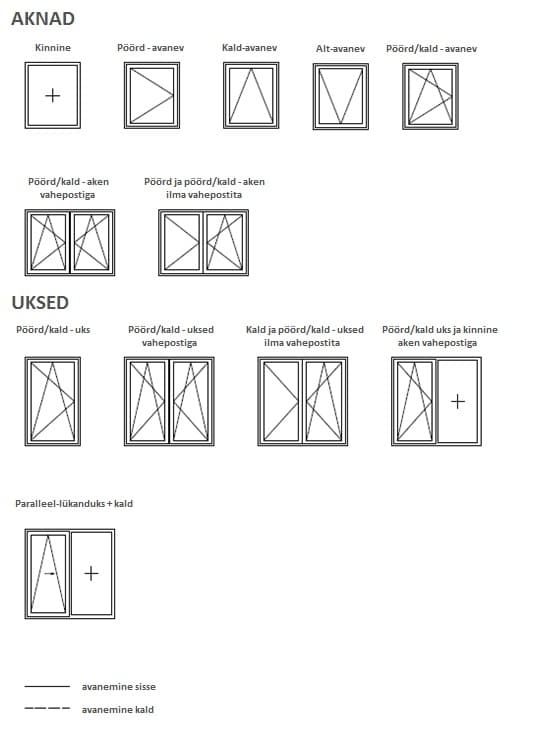
DOOR OPENINGS
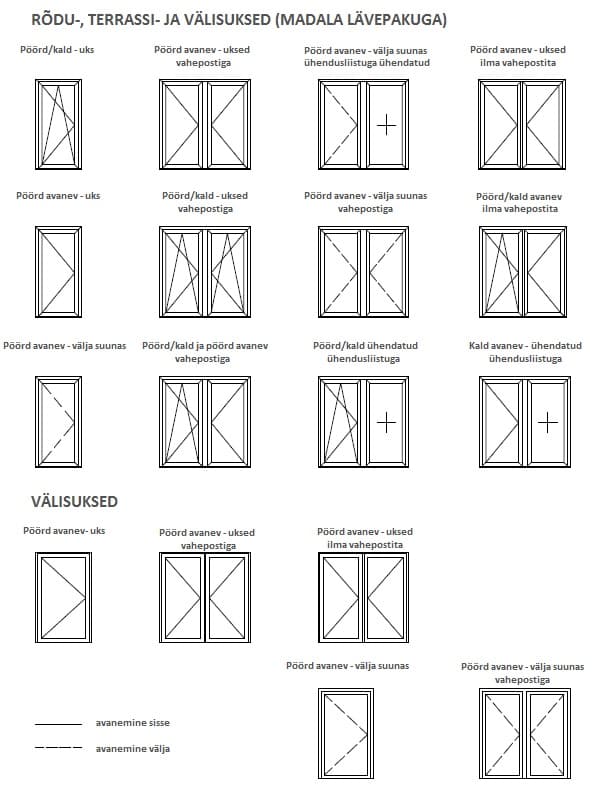
SPECIAL SHAPED ELEMENTS
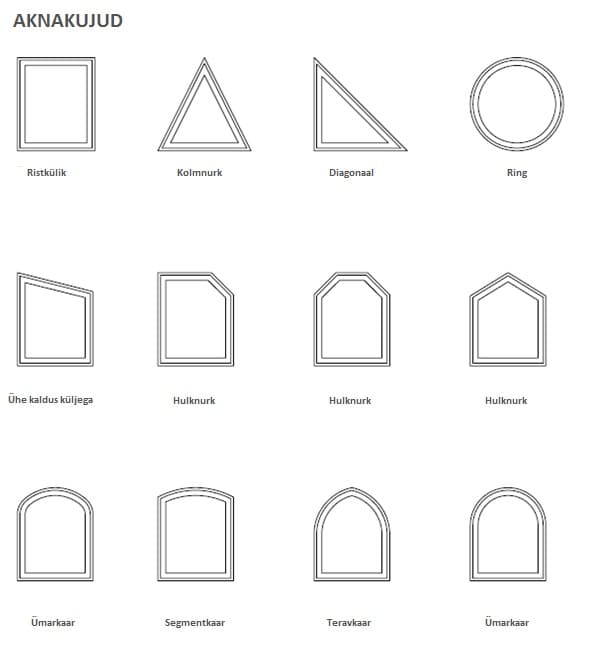
Scandinavian type opening windows
For two years now, we have also been offering top-swing windows that rotate on their axis and “Dannebrog” windows that resemble old wooden windows. Note that this type of window is 3-5 times more expensive than German windows.
TOP-SWING TYPE WINDOWS
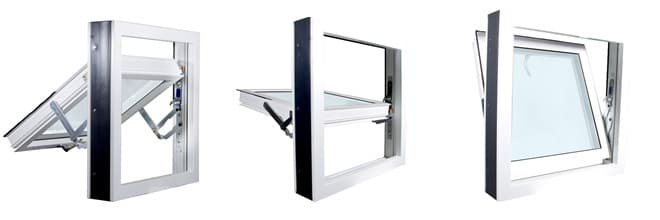
DANISH ("DANNEBROG") TYPE WINDOWS
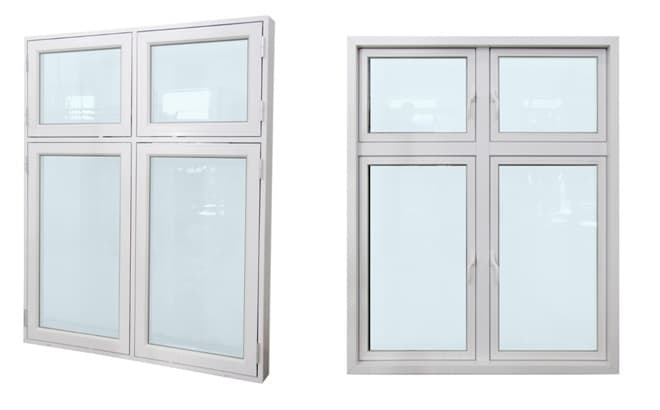
3. CHOOSE THE RIGHT GLASSES
You can choose from a wide range of glass types. The application and the location of the glass package play an important role in the product choice.
While single glazing was still used for wooden windows a decade ago, today single glazing is rare. Single glazing has been replaced by double or triple glazing units, which contain argon gas between the units and a selective layer on the inside of the unit to increase thermal performance.
In Estonia’s relatively cold climate, it’s worth considering a triple glazing package. Triple glazing packages are worth choosing, especially for private houses and flats in apartment blocks where the average annual room temperature is low (first floors (uninsulated cellars) or top floors (uninsulated attics)). In an apartment building, residents do not pay according to the amount of heating they use, but proportionally, which is why changing windows does not achieve the same result as in a private house.
Noise resistance and security also play an important role in the choice of glass packages. It is often mistakenly believed that better noise resistance is achieved by replacing a double glazing unit with a triple one. There is indeed a slight change, but to achieve better noise immunity, it is worth choosing thicker glasses in the first place.
If safety is important (e.g. large areas of glass), it is worth choosing a package with tempered or laminated glass. Safety glasses can help you protect yourself and your family from injuries caused by broken glass. Security glass also prevents unwanted attacks by burglars and intruders.
There is a really wide range of different glass packages. In addition to the above, energy-saving, solar control, tinted, decorative and self-cleaning glass packages are available.
In addition to the glass itself, the strip between the panes also plays an important role. There is a choice between a standard aluminium partition and a composite partition with plastic content. Plastic (ceramic) partitions prevent heat loss from the edges of the glass, avoiding the formation of a cold bridge. Foam is a poor conductor of heat, so cold does not reach the inner glass and it helps to prevent condensation on windows. Due to the poor thermal conductivity of this partition, heat cannot escape in winter and unwanted heat cannot penetrate in summer. The result is better insulated windows, lower heating costs and more comfortable indoor temperatures.
4. INSTALLATION | FINISHING
Just as important as quality windows is the installation of the windows, even the best insulated windows can be ruined if not installed according to the rules.
Windows and doors are installed with brackets or through-hung screws. If the site allows, the first recommendation is to always install all products through the gable. A product fixed with screws is securely fixed and fluctuations in the construction zone have less effect on the properties of the window. If the window is installed with brackets, it is important to ensure that the quantity and spacing of the brackets are as prescribed by the manufacturer. The base profile also needs to be clamped in place.
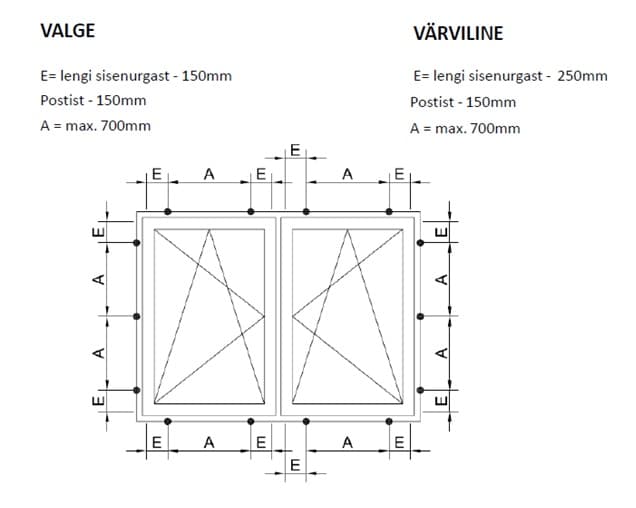
The next question concerns whether or not to install the windows with or without a base profile. The base profile facilitates the installation of the sill and water stop, but it is worth noting that the thermal performance of the base profile is poorer than the rest of the window. Therefore, it is worth considering the possibility of ordering windows without base profiles.
The window is fixed with special crowns or screws (dowels). Polyurethane foams (e.g. Soudal Penoflex) are used for heat sealing. Self-expanding gaskets or window installation tapes are used to seal from the outside. When sealing, the rule is – tighter on the inside than on the outside. The sealing must ensure that damp air from the inside does not penetrate the building structure (condensation), and from the outside the sealing must be rainproof and windproof, while allowing water vapour to pass through. To cover the connection joint, appropriate cover strips shall be used, which may be made of PVC, sheet or wood.
To prevent degradation of the external substrate and dangerous wetting of the walls and insulation, water stops are installed with the windows. The width of the water stop should be chosen so that the nose of the water stop extends above the façade by at least 3 cm (this will divert the water away from the façade surface when draining) but preferably not more than 6 cm (too large an overhang risks the wind breaking the sheeting). The length of the waterstop should be chosen so that, even after the ends of the sheet have been rolled up, it is still possible to overlap the side pieces onto the sheet to prevent water getting between the sheet and the sheet edges. If it is not possible to overcoat the exterior surface of the sheet, the interface between the waterstain and the sheet must be sealed with a sealant. The fixing of the watertight sheets shall be carried out by means of sheet-metal screws into the window base installation profile. If necessary, additional fixings in the side or base section are carried out on a case-by-case basis. When installing the sheeting, be sure to keep the slope of the sheeting at least 5° to the outside.
The window sills are installed from the inside against the mounting profile. The sills are installed at an angle of about 2° towards the room to divert any accidental water from the sill. The window sash is wedged evenly against the bottom frame from the rear edge and the front edge is supported by support blocks. In the case of long boards, they must be fixed against the top jamb during installation, as expansion of the polyurethane foam may cause the window board to deform. After the window sill is supported, it is insulated at the bottom with polyurethane foam. The fixation of the sills is ensured by the use of wedges, polyurethane foam and by covering the edges of the sills during the interior finishing.
If windows and/or doors are to be interconnected by means of joints/sections, ensure that joints of adequate strength are used. It is unsafe and unacceptable to connect two 100 kg products with a thin plastic strip. A self-expanding gasket is installed together with the connector to achieve a moisture and wind barrier.
READ MORE
Once the windows and sills have been installed, the interior finishing is next. There are a number of different ways to finish your interior. The most common version, and the one most practiced by window companies, is to finish the cheeks with plaster, plaster and paint them white. This is only one version. Window panes in sanitary rooms will be tiled. Wooden slats/slats are used in wooden houses. There really are many different options.
Watch the video for one way to finish plastic windows.
5. BUYING WINDOWS AND CHOOSING A WINDOW COMPANY
Once the preliminary work has been done and a decision has been made on the type/openings and characteristics of the windows and doors, it is time to start measuring the existing openings. A concise guide on how to measure windows can be found in the video.
Keep an eye out when measuring openings:
- In addition to the window, the opening must also accommodate an assembly foam. Depending on the situation of the opening, the recommended gap is 1-1,5cm.
- In which situation and how thick is the wall on which the window will rest.
- If it is a block of flats, how have other flats changed their windows. A complete façade can be achieved if the windows are all the same.
- Is it possible to install the window behind the frame, or do you need corner pieces on the outside to cover the junctions between the window and the wall.
- All windows are ordered based on the dimensions given by the customer e. as a special order, so please allow a few weeks for ordering. During the season, delivery can take up to 6-8 weeks, so it's worth starting your window replacement plans early. If you don't want to measure the windows yourself or you are not sure about the measurements, call in a Plasto measurer who will take the necessary measurements for you.
All questions can be answered by Plasto sales representatives throughout Estonia.
Later maintenance
When choosing a window, it’s also worth considering the maintenance it will need later on. Dusting and removing dirt from windows is elementary, but before the big frost comes, you should also check the cleanliness of the seals and lubricate them with silicone sealant or a special seal care stick. The locks also need maintenance – they should be cleaned, oiled and adjusted at least once a year. A clean and well-maintained window is also easy to use in winter.
The surface of the PVC profile can be wiped with a cloth dampened with a non-abrasive cleaner and then dried. For heavily soiled surfaces, you could use a special cleaning milk for PVC windows. Cleaning PVC profiles with window cleaners should be avoided: depending on the product, cleaning with them can cause static electricity to be generated on the window profile and the window will “attract” dust.
Normal maintenance (washing, lubrication) can usually be done by anyone. It’s a different story when it comes to adjusting windows, replacing seals or any other work affecting the performance of the window: these should be left to qualified professionals.
It doesn’t matter whether the windows are PVC or wooden – the condition of all windows should be constantly monitored. For example, if a chimney is running hard, the reason is usually not the chimney, but a blockage. A harder movement of the chimney is the first sign that the window seal should be checked and, if necessary, serviced or adjusted.




